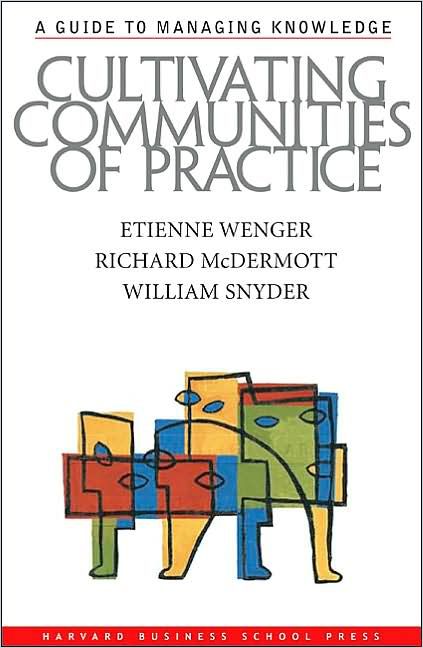Communities of practice experts provide a detail, knowledgeable overview of these groups and their operations.

Building Communities of Practice
Communities of Practice
Communities of practice harken back to medieval guilds where people who shared an occupation congregated to sharpen their skills and represent their field. Knowledge management consultants Etienne Wenger, Richard McDermott and William Snyder explain how today’s professionals who share a specialization can interact regularly to develop their expertise, solve problems, develop strategies and learn.
Wenger is a renowned pioneer in this field and his co-authors are experts, as well. The basis for this volume is Wenger’s foundational Communities of Practice. He also co-authored Digital Habitats and Situated Learning. The authors’ combined knowledge makes this book a great resource for anyone interested in knowledge management, community development and organizational culture.
Professional groups are vital to the emerging knowledge economy. Like other communities, they revolve around a core of committed members, as the authors explain. These groups balance preserving their discipline’s existing knowledge with accepting fresh perspectives. Wenger, McDermott and Snyder delineate the typical life cycle of such groups, from informal discussions defining the group’s domain and purpose to formal structures bringing far-flung professionals together.
Companies at the forefront of the knowledge economy are succeeding on the basis of communities of practice, whatever they call them.Etienne Wenger, Richard McDermott and William Snyder
The authors introduce the guiding principles of communities of practice and explain how they fit existing structures. Their discussion of groups of practice in the wider world may prove most relevant to readers who work outside a niche discipline. As Publishers Weekly said, the authors, “…target practitioners with pragmatic advice…Starting with a detailed explanation of what these groups really are and why they can prove so useful in managing knowledge within an organization…[they] discuss development from initial design through subsequent evolution.”
Sharing
Wenger, McDermott and Snyder detail how any group of people who share an interest and interact regularly to develop knowledge and expertise thereby form a community of practice.
Communities of practice are groups of people who share a concern, a set of problems, or a passion about a topic, and who deepen their knowledge and expertise…by interacting on an ongoing basis.Wenger, McDermott and Snyder
Too often, the authors lament, knowledge-management professionals deal with their data as if it were static – like a physical object. They remind you that knowledge is alive, and it evolves as conditions change. Wenger, McDermott and Snyder celebrate how communities of practice store this living knowledge and integrate its social components.
The authors state that communities of practice provide both short- and long-term value and offer tangible benefits – such as allowing members to pool their expertise to solve specific problems – and intangible benefits – such as building productive relationships. They also provide platforms for developing and implementing organizational strategies.
Members of communities of practice approach problems as participants in specific work teams and part of a knowledge discipline’s community; thus, they are knowledge users and knowledge “stewards,” as Wenger, McDermott and Snyder explain.
The authors offer seven principles to follow when you create a community of practice: design it to evolve; include insiders and outsiders; expect different levels of participation; plan public events and private meetings; generate value for community members; retain existing members and seek new ones; and expect periods of greater and lesser activity.
Caution
The authors caution that groups can fail to evolve. The energy the community pours into its field, Wenger, McDermott and Snyder suggest, might make members value that realm too highly. Or, they note, people might enjoy one another’s company so much they stop working on their domain, or they might focus so intently on current problems they forget their past and their knowledge stewardship function.
Stories are the best way to traverse the knowledge system in a way that explains the linkages between community activities, knowledge resources, and performance outcomes. Wenger, McDermott and Snyder
The authors regard stories as crucial explanations of the causal links between community activity and company benefit. If need be, they recommend, hire a community coordinator to help people shape and collect stories. Weave those stories of individual benefit into the organization’s larger picture.
The Larger World
Wenger, McDermott and Snyder demonstrate how communities of practice benefit the larger world. Starting with directly connected businesses, they reveal, communities of practice can lead to intra-industry study teams and bring disciplinary expertise to bear on a single shared problem.
Communities of practice are everywhere. We all belong to…them – at work, at school, at home, in our hobbies.Wenger, McDermott and Snyder
The authors also note that citizens can form communities of practice within the larger civic arena, according to their shared values or their area’s known needs, from educational processes to nutrition. Wenger, McDermott and Snyder cite the World Bank, for example, for its ability to connect communities and individuals from different countries to share knowledge and address problems.
An Analytical Approach
Wenger, McDermott and Snyder are significant inside practitioners in the universe of communities of practice, and they assume their readers want as much inside knowledge as possible. Depending on your passion for the subject, their in-depth detail and rather dry style might dilute your reading pleasure or retention. The authors offer no detailed, organized blueprint for creating and maintaining a community of practice. They describe a community’s attributes and likely pitfalls, but this remains a work of analysis, not a how-to manual. As such, it may be more valuable for students, instructors and organizers than citizens seeking to organize around an enthusiasm or professionals seeking to evoke the guilds of old.



